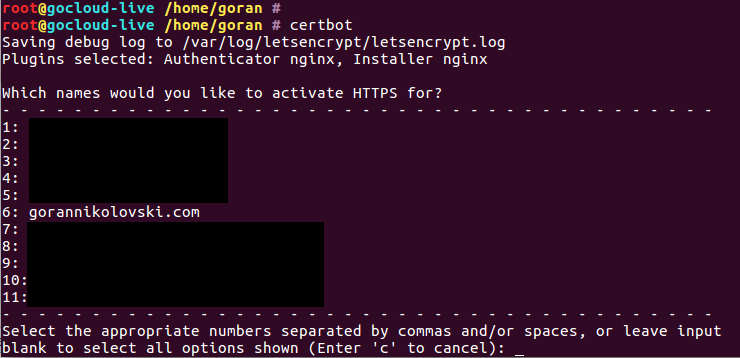This site is powered by Drupal 10. I'm using Nginx as a web server and Let's Encrypt to add HTTPS encryption to my site. In this blog post, I will show you how my Nginx config file looks like.
My domain is gorannikolovski.com
All requests are redirected to the https-without-www version. That means that if a user types any of these:
- http://www.gorannikolovski.com
- https://www.gorannikolovski.com
- http://www.gorannikolovski.com
he or she will be redirected to https://gorannikolovski.com
Here is my Nginx config file:
server {
server_name gorannikolovski.com;
root /var/www/gorannikolovski.com/web; ## <-- Your only path reference.
access_log /var/log/web/gorannikolovski.com_access_log;
error_log /var/log/web/gorannikolovski.com_error_log;
gzip on;
gzip_comp_level 6;
gzip_vary on;
gzip_min_length 1000;
gzip_proxied expired no-cache no-store private auth;
gzip_types text/plain application/javascript application/x-javascript text/javascript text/xml text/css;
gzip_disable "MSIE [1-6]\.";
location = /favicon.ico {
log_not_found off;
access_log off;
}
location = /robots.txt {
allow all;
log_not_found off;
access_log off;
}
# Very rarely should these ever be accessed outside of your lan
location ~* \.(txt|log)$ {
allow 192.168.0.0/16;
deny all;
}
location ~ \..*/.*\.php$ {
return 403;
}
location ~ ^/sites/.*/private/ {
return 403;
}
# Allow "Well-Known URIs" as per RFC 5785
location ~* ^/.well-known/ {
allow all;
}
# Block access to "hidden" files and directories whose names begin with a
# period. This includes directories used by version control systems such
# as Subversion or Git to store control files.
location ~ (^|/)\. {
return 403;
}
location / {
# try_files $uri @rewrite; # For Drupal <= 6
try_files $uri /index.php?$query_string; # For Drupal >= 7
}
location @rewrite {
rewrite ^/(.*)$ /index.php?q=$1;
}
# Don't allow direct access to PHP files in the vendor directory.
location ~ /vendor/.*\.php$ {
deny all;
return 404;
}
# In Drupal 8, we must also match new paths where the '.php' appears in
# the middle, such as update.php/selection. The rule we use is strict,
# and only allows this pattern with the update.php front controller.
# This allows legacy path aliases in the form of
# blog/index.php/legacy-path to continue to route to Drupal nodes. If
# you do not have any paths like that, then you might prefer to use a
# laxer rule, such as:
# location ~ \.php(/|$) {
# The laxer rule will continue to work if Drupal uses this new URL
# pattern with front controllers other than update.php in a future
# release.
location ~ '\.php$|^/update.php' {
fastcgi_split_path_info ^(.+?\.php)(|/.*)$;
# Security note: If you're running a version of PHP older than the
# latest 5.3, you should have "cgi.fix_pathinfo = 0;" in php.ini.
# See http://serverfault.com/q/627903/94922 for details.
fastcgi_param APP_ENV GOCLOUD-LIVE;
include fastcgi_params;
# Block httpoxy attacks. See https://httpoxy.org/.
fastcgi_param HTTP_PROXY "";
fastcgi_param SCRIPT_FILENAME $document_root$fastcgi_script_name;
fastcgi_param PATH_INFO $fastcgi_path_info;
fastcgi_param QUERY_STRING $query_string;
fastcgi_intercept_errors on;
fastcgi_pass 127.0.0.1:9000;
}
# Fighting with Styles? This little gem is amazing.
# location ~ ^/sites/.*/files/imagecache/ { # For Drupal <= 6
location ~ ^/sites/.*/files/styles/ { # For Drupal >= 7
try_files $uri @rewrite;
}
# Handle private files through Drupal. Private file's path can come
# with a language prefix.
location ~ ^(/[a-z\-]+)?/system/files/ { # For Drupal >= 7
try_files $uri /index.php?$query_string;
}
location ~* \.(js|css|png|jpg|jpeg|gif|ico|svg)$ {
try_files $uri @rewrite;
expires max;
log_not_found off;
}
listen 443 ssl; # managed by Certbot
ssl_certificate /etc/letsencrypt/live/gorannikolovski.com/fullchain.pem; # managed by Certbot
ssl_certificate_key /etc/letsencrypt/live/gorannikolovski.com/privkey.pem; # managed by Certbot
}
server {
if ($host = gorannikolovski.com) {
return 301 https://$host$request_uri;
} # managed by Certbot
server_name gorannikolovski.com;
listen 80;
return 404; # managed by Certbot
}
server {
listen 80;
server_name www.gorannikolovski.com;
return 301 https://gorannikolovski.com$request_uri;
}
server {
listen 443 ssl http2;
server_name www.gorannikolovski.com;
ssl_certificate /etc/letsencrypt/live/gorannikolovski.com/fullchain.pem;
ssl_certificate_key /etc/letsencrypt/live/gorannikolovski.com/privkey.pem;
return 301 https://gorannikolovski.com$request_uri;
}
Code blocks that are commented with # managed by Certbot are automatically inserted by Certbot. Certbot is a tool that is installed on your server and by running one command:
certbot
you can choose domains for which you want to add Let's Encrypt HTTPS encryption. This is how that looks like:
Now, that's pretty cool.
Certbot will update your config files so that you don't have to manually do that. I'm using Ubuntu 20.04 on my server so I followed these instructions: ubuntubionic-nginx to install Certbot, but there are also instructions for many other systems.




